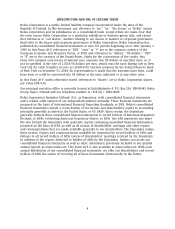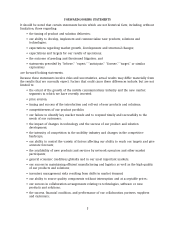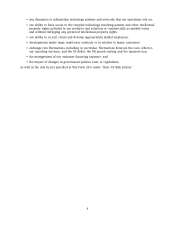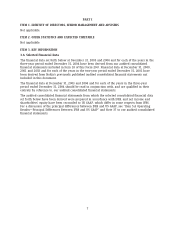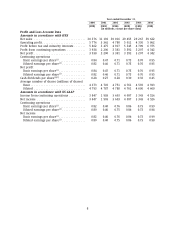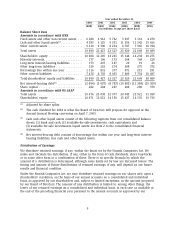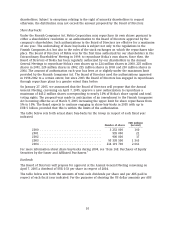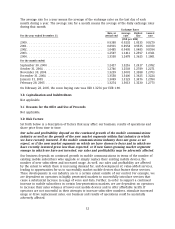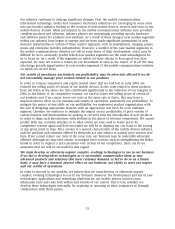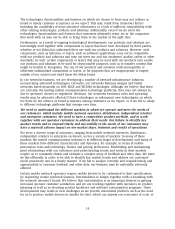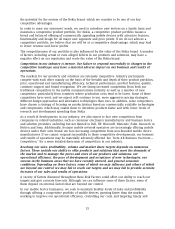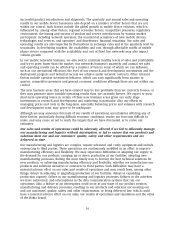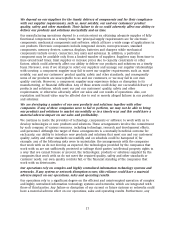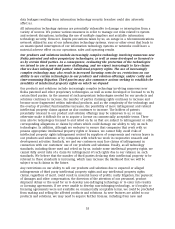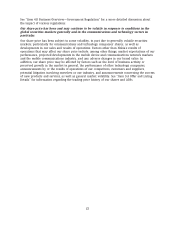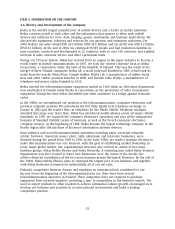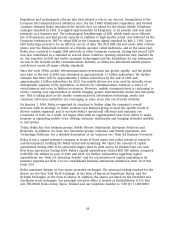Nokia 2004 Annual Report Download - page 15
Download and view the complete annual report
Please find page 15 of the 2004 Nokia annual report below. You can navigate through the pages in the report by either clicking on the pages listed below, or by using the keyword search tool below to find specific information within the annual report.The technologies, functionalities and features on which we choose to focus may not achieve as
broad or timely customer acceptance as we expect. This may result from numerous factors
including the availability of more attractive alternatives or a lack of sufficient compatibility with
other existing technologies, products and solutions. Additionally, even if we do select the
technologies, functionalities and features that customers ultimately want, we or the companies
that work with us may not be able to bring them to the market at the right time.
Furthermore, as a result of ongoing technological developments, our products and solutions are
increasingly used together with components or layers that have been developed by third parties,
whether or not Nokia has authorized their use with our products and solutions. However, such
components, such as batteries, or layers, such as software applications, may not be compatible
with our products and solutions and may not meet our and our customers’ quality, safety or other
standards. As well, certain components or layers that may be used with our products may enable
our products and solutions to be used for objectionable purposes, such as to transfer content that
might be hateful or derogatory. The use of our products and solutions with incompatible or
otherwise substandard components or layers, or for purposes that are inappropriate, is largely
outside of our control and could harm the Nokia brand.
In our networks business, we are developing a number of network infrastructure solutions
incorporating advanced technologies. Currently, our networks business designs and builds
networks based primarily on GSM, EDGE and WCDMA technologies. Although we believe that these
are currently the leading mobile communications technology platforms, they may not always be,
due to operators’ choices or regulators’ decisions. Our networks business’s sales and operating
results may be adversely affected if these technologies or subsequent new technologies on which
we focus do not achieve as broad acceptance among customers as we expect, or if we fail to adapt
to different technology platforms that emerge over time.
We need to understand the different markets in which we operate and meet the needs of
our customers, which include mobile network operators, distributors, independent retailers
and enterprise customers. We need to have a competitive product portfolio, and to work
together with our operator customers to address their needs. Our failure to identify key
market trends and to respond timely and successfully to the needs of our customers may
have a material adverse impact on our market share, business and results of operations.
We serve a diverse range of customers, ranging from mobile network operators, distributors,
independent retailers to enterprise customers, across a variety of markets. In many of these
markets, the mobile communications industry is at different stages of development, and many of
these markets have different characteristics and dynamics, for example, in terms of mobile
penetration rates and technology, feature and pricing preferences. Establishing and maintaining
good relationships with our customers and understanding trends and needs in their markets
require us to constantly obtain and evaluate a complex array of feedback and other data. We must
do this efficiently in order to be able to identify key market trends and address our customers’
needs proactively and in a timely manner. If we fail to analyze correctly and respond timely and
appropriately to customer feedback and other data, our business may be materially adversely
affected.
Certain mobile network operators require mobile devices to be customized to their specifications,
by requesting certain preferred features, functionalities or design, together with co-branding with
the network operator’s brand. We believe that customization is an important element in gaining
increased operator customer satisfaction and we are working together with operators on product
planning as well as accelerating product hardware and software customization programs. These
developments may result in new challenges as we provide customized products, such as the need
for us to produce mobile devices in smaller lot sizes, which can impede our economies of scale, or
14


